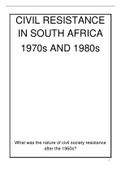Summary
Summary Civil resistance in SA in 1970-80
- Course
- History
- Institution
- 12th Grade
Focuses on What was the nature of civil society resistance after the 1960s? THE CHALLENGE OF BLACK CONSCIOUSNESS TO APARTHEID The Opposition – underground, in prison and in exile The nature and aims of Black Consciousness The role of Steve Biko: his ideas and writing and lots more.
[Show more]



